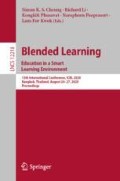Abstract
This study explored the potential of using augmented reality (AR) technology in designing makerspace-based education in the elementary school setting. Employing the design-based research methodology, this study proposed and successively refined a set of instructional design principles for facilitating AR–supported collaborative inquiry through three iterations of design, implementation and revision. The affordances of AR were found to promote student engagement in collaborative exploration and task completion. Moreover, several pedagogical implications based on the empirical data were discussed, highlighting the importance of interdisciplinary integration, general inquiry sequence, proper scaffolding strategies, opportunities for transfer learning, and abundant instruction time for makerspace-based education.
Access this chapter
Tax calculation will be finalised at checkout
Purchases are for personal use only
References
Anderson, C.: Makers: The New Industrial Revolution. Crown Business, New York (2012)
Forest, C.R., et al.: The invention studio: a university maker space and culture. Adv. Eng. Educ. 4, 1–32 (2014)
Smith, A., Hielscher, S., Dickel, S., Soderberg, J., van Oost, E.: Grassroot digital fabrication and makerspaces: reconfiguring, relocating and recalibrating innovation. Sci. Technol. Policy Res. 2, 1–20 (2013)
Blackley, S., Sheffield, R., Maynard, N., Koul, R., Walker, R.: Makerspace and reflective practice: advancing pre-service teachers in STEM education. Aust. J. Teach. Educ. (Online) 42, 22–37 (2017)
Blackley, S., Rahmawati, Y., Fitriani, E., Sheffield, R., Koul, R.: Using a makerspace approach to engage indonesian primary students with STEM. Issues Educ. Res. 28, 18–42 (2018)
Wang, Y.M., Qian, K.L., Hua, J., Guo, J.: Experiencing real learning: towards a new culture of maker education-review of the researches of maker education at home and abroad. E-educ. Res. 2, 34–43 (2017)
Yang, X., Li, J.: The potential value of maker education and its disputes. Mod. Dist. Educ. Res. 2, 23–34 (2015)
Ibáñez, M.B., Delgado-Kloos, C.: Augmented reality for STEM learning: a systematic review. Comput. Educ. 123, 109–123 (2018)
Kerawalla, L., Luckin, R., Seljeflot, S., Woolard, A.: “Making it real”: exploring the potential of augmented reality for teaching primary school science. Virtual Reality 10, 163–174 (2006)
Chang, H.-Y., Wu, H.-Y., Hsu, Y.-S.: Integrating a mobile augmented reality activity to contextualize student learning of a socioscientific issue. Br. J. Educ. Technol. 44, 95–99 (2013)
Wang, H.-Y., Duh, H.B.-L., Li, N., Lin, T.-J., Tsai, C.-C.: An investigation of university students’ collaborative inquiry learning behaviors in an augmented reality simulation and a traditional simulation. J. Sci. Educ. Technol. 23(5), 682–691 (2014). https://doi.org/10.1007/s10956-014-9494-8
Akçayır, M., Akçayır, G.: Advantages and challenges associated with augmented reality for education: a systematic review of the literature. Educ. Res. Rev. 20, 1–11 (2017)
NMC Horizon Report. https://library.educause.edu/resources/2018/8/2018-nmc-horizon-report
Moore, T.J., Guzey, S.S., Brown, A.: Greenhouse design to increase habitable land: an engineering unit. Sci. Scope 37, 51–57 (2014)
Stoneburner, D.: From STEM to STEAM: using brain-compatible strategies to integrate the arts. Roeper Rev. 38, 129–130 (2013)
Lewis, T.: Design and inquiry: bases for an accommodation between science and technology education in the curriculum. J. Res. Sci. Teach. 43, 255–281 (2006)
Vygotsky, L.S.: Mind in Society: The Development of Higher Psychological Processes. Harvard University Press, Cambridge (1978)
Belland, B.R.: Handbook of Research on Educational Communications and Technology. Springer, New York (2014). https://doi.org/10.1007/978-1-4614-3185-5
Gu, X., Shao, Y., Guo, X., Lim, C.P.: Designing a role structure to engage students in computer-supported collaborative learning. Internet High. Educ. 24, 13–20 (2015)
van Gog, T., Kester, L., Paas, F.: Effects of worked examples, example-problem, and problem-example Pairs on novices’ learning. Contemp. Educ. Psychol. 36, 212–218 (2011)
Paas, F., van Gog, T.: Optimising worked example instruction: different ways to increase Germane cognitive load. Learn. Instr. 16, 87–91 (2006)
Clark, R.C., Nguyen, F., Sweller, J., Baddeley, M.: Efficiency in learning: evidence-based guidelines to manage cognitive load. Perform. Improv. 45, 46–47 (2006)
Renkl, A.: Toward an instructionally oriented theory of example-based learning. Cogn. Sci. 38, 1–37 (2014)
Huang, Y.-H., Lin, K.-C., Yu, X., Hung, J.C.: Comparison of different approaches on example-based learning for novice and proficient learners. Hum.-Centric Comput. Inf. Sci. 5, 5–29 (2015)
Acknowledgment
This study was supported by the National Office for Education Sciences Planning of China under Grant BCA190085. We would also like to thank the Bao’an school district in the city of Shenzhen for their support during the research.
Author information
Authors and Affiliations
Corresponding author
Editor information
Editors and Affiliations
Rights and permissions
Copyright information
© 2020 Springer Nature Switzerland AG
About this paper
Cite this paper
Han, X., Liu, Y., Li, H., Fan, Z., Luo, H. (2020). Augmenting the Makerspace: Designing Collaborative Inquiry Through Augmented Reality. In: Cheung, S., Li, R., Phusavat, K., Paoprasert, N., Kwok, L. (eds) Blended Learning. Education in a Smart Learning Environment. ICBL 2020. Lecture Notes in Computer Science(), vol 12218. Springer, Cham. https://doi.org/10.1007/978-3-030-51968-1_13
Download citation
DOI: https://doi.org/10.1007/978-3-030-51968-1_13
Published:
Publisher Name: Springer, Cham
Print ISBN: 978-3-030-51967-4
Online ISBN: 978-3-030-51968-1
eBook Packages: Computer ScienceComputer Science (R0)

